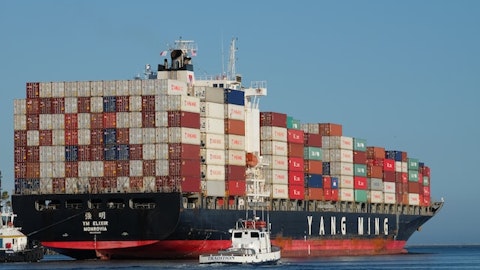Avista Corporation (NYSE:AVA) Q4 2022 Earnings Call Transcript February 22, 2023
Operator: Good day, and thank you for standing by. Welcome to the Avista Corporation Q4 2022 Earnings Conference Call. At this time, all participants are in a listen-only mode. After the speakers’ presentation, there will be a question-and-answer session. Please be advised that today’s conference is being recorded. I would now like to hand the conference over to your speaker today, Stacey Wenz, Investors Relations Manager. Please go ahead.
Stacey Wenz: Good morning. Welcome to Avista’s fourth quarter and fiscal year 2022 earnings conference call. Our earnings and our 2022 Form 10-K were released pre-market this morning, both are available on our website. Joining me this morning, our Avista Corp., President and CEO, Dennis Vermillion; Executive Vice President, Treasurer and CFO, Mark Thies; Senior Vice President, External Affairs and Chief Customer Officer, Kevin Christie; and Vice President Controller and Principal Accounting Officer, Ryan Krasselt. Some of the statements we will make today are forward-looking and involve assumptions, risks and uncertainties, which are subject to change. For reference to the various factors, which could cause results to differ materially from those discussed in today’s call, please refer to our 10-K for 2022, which is available on our website.
I’ll begin by recapping the financial results presented in today’s press release. For the full-year, consolidated earnings were $2.12 per diluted share for 2022 compared to $2.10 last year. Our consolidated earnings for the fourth quarter of 2022 were $1.05 per diluted share compared to $0.71 for the fourth quarter of 2021. Now I’ll turn the discussion over to Dennis.
Dennis Vermillion: Well, thanks, Stacey and good morning, everyone. I hope the new year is off to a great start for you all. Avista ended 2022 with a memorable accomplishment in November. Mark and Kevin and I were among a group of Senior Executives and Board Members who stood on the podium above the New York Stock Exchange to ring the closing bell to celebrate our 70th anniversary of being listed on the NYSE. It was pretty cool. We are among the top 10% of the longest listed members of the NYSE. Very few companies can state claim to such an extraordinary achievement. As Avista’s President and CEO, I couldn’t be more proud of all the current and former employees who came before us, who helped achieve this major milestone. We certainly could not have done it without them, and it was certainly an honor for me, a very special experience that I’ll never forget.
If you look back over more than 133 years to when our business was founded, you will see that our employees always demonstrate their diligence and determination to pull us through challenging times. That’s certainly true for 2022. We worked hard to manage our costs and run our business amidst the highest inflation in decades. We had extreme volatility in the power and natural gas markets and of course, a rapid rise in interest rates. Despite our efforts, Avista Utilities’ earnings were slightly below expectations. On a consolidated basis, our earnings were better than our expectations due to a significant increase in the fair value of certain non-regulated investments. And Mark will have a little bit more on that in a minute. As we begin 2023, I’m counting on the grit and determination of our employees to propel us forward, and I know they will answer the call once again, just like they always do.
So for 2023, regulatory outcomes are key to our success. The Washington Commission’s approval of the settlement agreement in our multi-year rate cases in December was the first step. And earlier this month, we filed a multi-year rate plan in Idaho that would allow the company to recover the cost of our ongoing investments in utility infrastructure and the increased operating costs that we experienced in 2022. We also plan to file a general rate case in Oregon within the next few weeks. We expect rates associated with this case to go into effect in January of 2024. We continue to execute on our Clean Energy Implementation Plan and we’ve taken steps toward achieving our aspirational clean energy goals, including issuing a request for proposal to seek renewable natural gas resources for our customers and signing contracts for renewable, hydro and wind resources to meet our customers energy needs.
As we work through this clean energy transition, we believe that natural gas serves an important role to support both the reliability and affordability for our customers, especially for those most vulnerable among us. In December, we updated Avista’s corporate responsibility report, which showcases recent examples and the latest data that demonstrate our commitment to our environment, our people, our customers, and communities, and along with our shareholders. This latest update includes Avista’s aspirational goals for workplace equity, inclusion and diversity, an aspirational goal related to supplier diversity and Avista’s continued reporting on a series of key industry ESG disclosures and metrics. Finally, earlier this month, the Board increased our dividend by 4.5% to an annual dividend of $1.84.
The dividend increase approved by the Board marks the 21st consecutive year the Board has raised the dividend for our shareholders. This demonstrates the Board commitment to maximizing shareholder value. At this time, I’d like to invite Mark to discuss our earnings. Mark, take it away.
Mark Thies: Thanks, Dennis. Good morning, everyone, and just to keep the positive energy of this call going. The Blackhawks won their third straight last night, and Tyler Johnson, a local Spokane kid scored the game tie-in goal with less than a minute to go and scored the only goal in the shootout. So the Blackhawks beat the goal, the nice three to two, so a little positivity. We are still in the third place in The Connor Bedard lottery sweepstakes, which were not very good this year. Our consolidated earnings on the other hand were good this year, and they were largely, as Dennis said, primarily due to our other businesses. Our other businesses contributed $0.41 per share in 2022 compared to $0.21 in 2021. The majority of these earnings were really the result of the significant increase in the fair value of an investment in the biotechnology company, a bioscience company.
Our original investment in this company was for the development of biofuels, really to tie to our core, but it was later acquired and the focus shifted to biotechnology. Their patented biologic drug platform accelerates the time to market for orally administrative antibody drugs and has advanced through testing stages. As a result, the value of this investment has increased significantly, and they are in various stages of clinical trials right now, and we don’t expect results really until the end of 2024. So there’s going to be some time before we have significant updates on that as our expectation. For 2022 Avista Utilities contributed to $1.61 per share compared to a $1.79 in 2021. This was, as Dennis mentioned, just slightly below our expectations, and was a result of extreme volatility in the power and natural gas markets across the west, leading to higher power supply costs.
In December, we observed prices as much as 5x to 8x higher than normal, along with colder temperatures throughout November and December, and that’s the coldest we’ve seen in over 20 years. This volatility led to significant margin calls, which impacted our available liquidity and required us to secure additional short-term borrowing arrangements, which we did in the fourth quarter. Avista Utilities earnings reflect the result of the combined pressures of just the power supply costs that I talked about, interest expense, higher interest expense, and inflation. The energy recovery mechanism in Washington was a pre-tax expense of $10.9 million compared to a pre-tax expense of $7.7 million in the prior year. So our total deferred power costs exceed $30 million in 2022, and as a result, we expect to file with the Washington Commission in April to begin recovering these costs in July of 2023.
With respect to our capital expenditures, we continue to invest the necessary capital in our utility infrastructure to maintain a safe and reliable, standard of service as we always expect. In that, we expect those capital expenditures to be $475 million annually through 2025. We expect AEL&P capital to be $16 million in 2023, $14 million in 2024 and 16 million again in 2025. As I talked about liquidity a little bit earlier. In 2022, we issued $400 million of long-term debt and $138 million of common stock. We had a significant about $250 million maturity in there too, just to give the difference. In the fourth quarter, we experienced significant increases in commodity prices and the need for additional liquidity, as I mentioned earlier, but we increased our short-term borrowing capacity by $300 million, bringing our total capacity to $700 million.
As of 12/31, we had $517 million outstanding under these facilities, so we had a $183 million of available liquidity at year-end. In 2023, we expect to reduce our short-term borrowings. In part, we expect to increase operating revenues resulting from recovery of some of those deferred power and natural gas costs, a return of margin deposits made with counterparties, and we expect to issue $200 million in long-term debt and up to $120 million of common stock to fund planned expenditures and reduce our short-term borrowings. We expect to increase our capacity in our $400 million revolving credit facility from $400 million to $500 million in the second quarter. AEL&P also has $25 million of available liquidity under its committed line of credit and that expires in November 2024.
I want to give a little bit of discussion on our earnings guidance. As Dennis mentioned, we confirmed our 2023 earnings guidance with a range of $2.27 to $2.47 per diluted share. Our guidance assumes timely and appropriate rate relief in all of our jurisdictions. And as Dennis mentioned, we recently filed a multi-year plan in Idaho. Constructive outcomes in these cases are key to our success, as is the ongoing management of our costs. We expect Avista Utilities to contribute in the range of $2.15 to $2.31 per diluted share. The midpoint of our guidance does not include any expense or benefit under the energy recovery mechanism, and we expect to be within the deadband, the $4 million on either side of the midpoint with an increase in earnings of $0.03 per diluted share.
We expect to manage our costs, as I mentioned earlier, that’s part of it to an increase of 2% in O&M in 2023. Our 2023 earnings guidance reflects unrecovered structural costs estimated to reduce our return on equity by approximately 70 basis points, as well as continued regulatory timing lag that we’re working to reduce that reduces our return on equity by approximately 80 basis points. So this results in an expected return on equity for Avista Utilities of approximately 7.9% in 2023. We expect AEL&P to contribute in the range of $0.08 to $0.10 per diluted share. And our outlook there for Avista Utilities and AEL&P continues to include normal precipitation and hydroelectric generation for the year. We expect our other businesses to contribute $0.04 to $0.06, and I know this may sound a little bit, we’ve had two years of significant earnings in those, but those are we don’t predict the valuations of some of these companies.
We just continue to watch as they grow and we’ll record the results as they occur. So we expect that from a general perspective, $0.04 to $0.06 per share is what we are putting out in our guidance. Our guidance also generally only includes normal operating conditions and does not include any unusual or non-recurring items until the effects of those are known and certain. I’ll now turn the call back over to Stacey.
Stacey Wenz: Thanks, Mark. You are happy to take your questions.
Q&A Session
Follow Baumann Investment Co (NYSE:AVA)
Follow Baumann Investment Co (NYSE:AVA)
Operator: Thank you. Our first question comes from the line of Brian Russo from Sidoti.
Brian Russo: Hi, good morning.
Dennis Vermillion: Good morning, Brian.
Mark Thies: Good morning, Brian.
Brian Russo: Hey. You mentioned a renewable RFP earlier, could you just give some more detail on the size of that and do you expect possibly to submit self-builds and maybe The Inflation Reduction Act makes your self-build projects more competitive than in the past?
Dennis Vermillion: Yes, Brian, this is Dennis. The renewable RFP’s that I was referring to in my remarks is related to renewable natural gas. So from that perspective, this is our first RFP for renewable for R&G, basically to supply our customers. On the electric side, we’ve completed all source RFP, and I mentioned some we haven’t announced anything from that yet, but we are nearing completion on a couple contracts with regard to that. Certainly with the federal money that’s available, we have a team of people internal that are exploring opportunities to capture some of that money for a number of potential uses electric, EVs, grid hardening and resiliency, hydro efficiency upgrades. So we are looking and evaluating where we might be able to capture some of that value. That could be applied to a self-build option in the future. But really at this point, we have no detail on what that might look like.
Brian Russo: Okay. Thank you for the clarification. And then on the ERM, Mark, I think you said, you’re going to be in the $4 million deadband benefit, which would add $0.03 relative to the midpoint. And if so, maybe you could just describe, given all the volatility in power and gas prices in your region, what are the dynamics that allow you to forecast that?
Mark Thies: Well, that’s just a normal forecasting dynamic. We do this every quarter, every year, every day. So I don’t know that it’s a change to that dynamic. What we did see in the fourth quarter was significant changes and that really put pressure more on liquidity for physicians as we hedge our positions going into a winter, we have some positions hedged and it caused some significant liquidity constraints, not necessarily. We have some deferrals in our natural gas costs because would also cause higher costs, but those get deferred and recovered in future regulatory proceedings, we’ll file future PGAs, in our jurisdictions to the extent we had higher costs there on the gas side, we defer it. On the power side, it goes through the ERM or the PCA, and as I mentioned, the ERM did hit $30 million level and that allows us to file with the Washington Commission to seek recovery of those dollars.
So it’s really the it’s more on the liquidity side and the cash side. Then the earnings were impacted by that because the ERM did go up. We were in the 90, 10 in 2022, and the PCA, so we took 10% of that. So that did cause our earnings to miss slightly in the fourth quarter. As we forecast forward, we forecast with forward prices compared to our authorized power supply costs for the ERM and the availability of our units and we come up with those calculations and that’s where we ended up with the $0.03. That’s what we expect currently that can change Brian, as conditions change and we report that every quarter. So that’s where we sit today looking at forward prices for 2023.
Brian Russo: Okay. Very good. Thank you very much.
Mark Thies: Okay. Thanks, Brian.
Dennis Vermillion: Thanks, Brian.
Operator: Thank you. Our next question comes from the line of from Bloomberg. Fanny Three from Bloomberg. Your line is now open. Please check your mute button. Your line is now open. Our next question comes from the line of Fanny Three from Bloomberg. Your line is now open. Fanny Three from Bloomberg. Your line is now open. Please check your mute button. Your line is now open.
Dennis Vermillion: We may just need to move to the next question, operator, if that’s if that’s all right and she can come back Fanny, if that’s okay, have him come back. He or she, I don’t know if Fannie is.
Operator: Of course, at this time, I’m showing no further questions. I would like to turn the conference back to Stacey Wenz for closing remarks.
Stacey Wenz: Thank you all for your interest in Avista and joining us on our call today. Have a great day.
Operator: This concludes today’s conference call. Thank you for participating. You may now disconnect.




